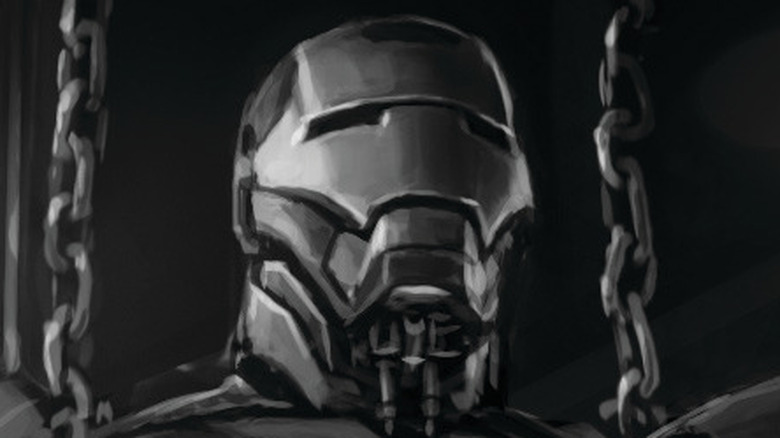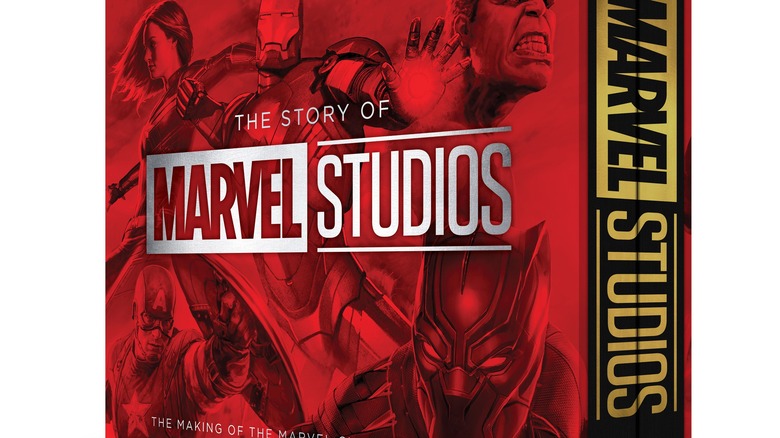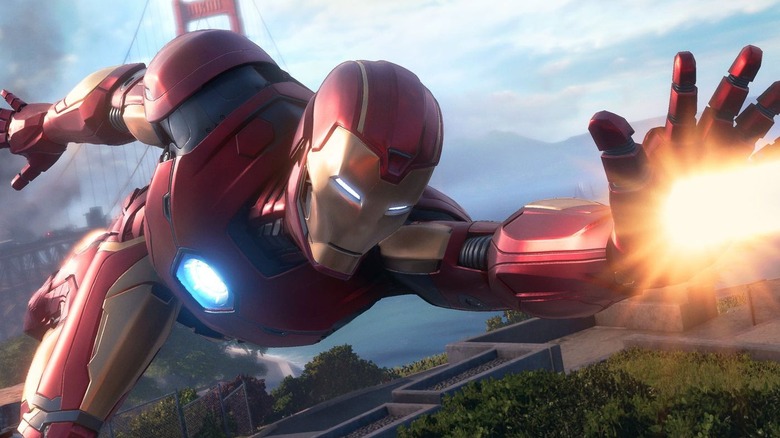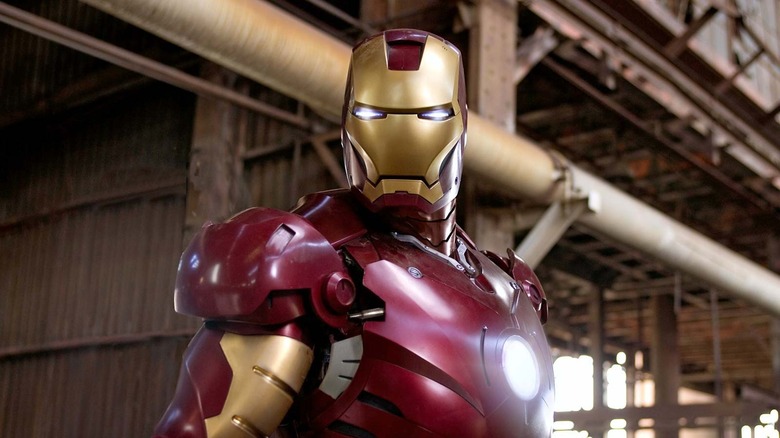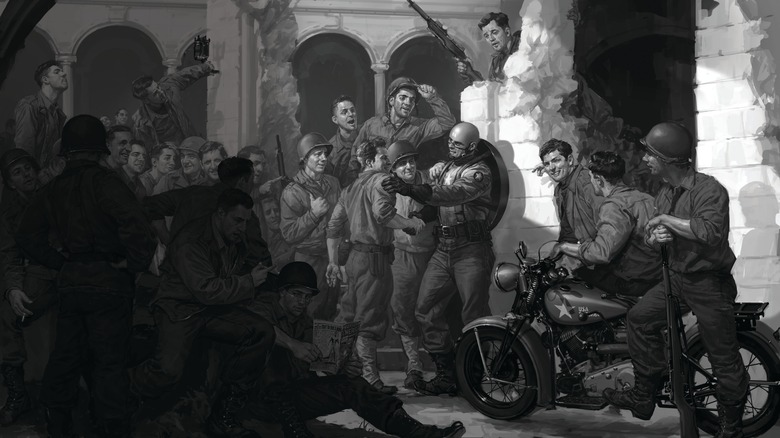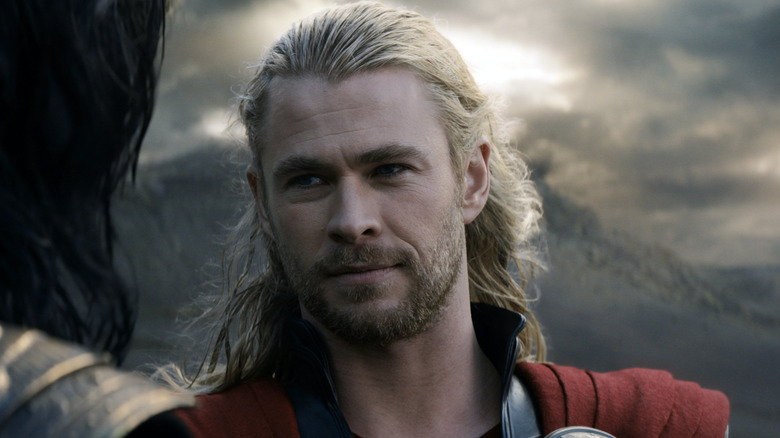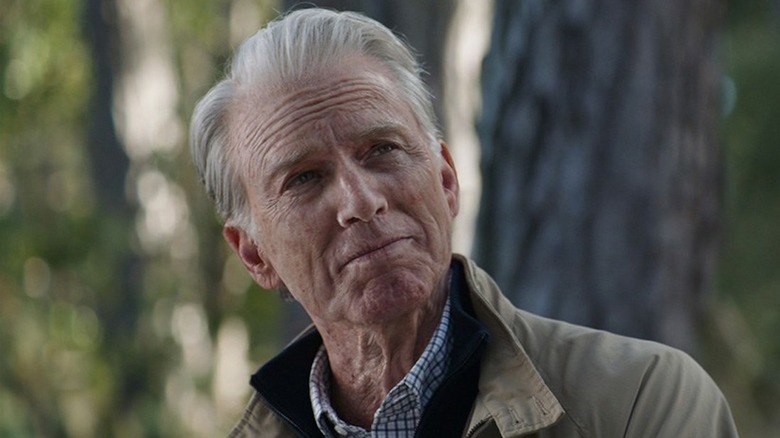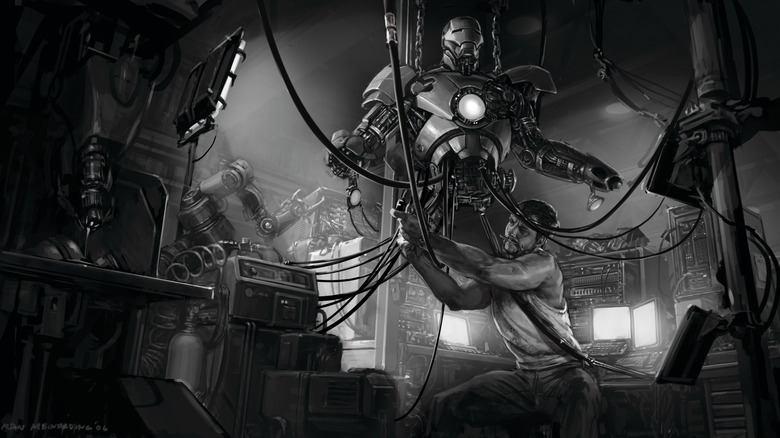MCU Head Of Visual Development Ryan Meinerding Dishes On The Story Of Marvel Studios - Exclusive Interview
When people think of the impact of the MCU, names like Chris Evans and Robert Downey Jr. typically come to the tip of the tongue. While the actors who bring our favorite heroes to life are certainly integral to the franchise's success, there are a whole lot of folks behind the scenes tasked with mapping out this universe and its characters long before roles are even cast. Marvel Studios' head of visual development and character design Ryan Meinerding is one such person, and the MCU wouldn't exist as we know it today if it weren't for him and his business partner Charlie Wen. Steve Rogers and Iron Man have nothing on these guys.
Now, to bring fans a little piece of what exactly went into making this epic franchise, writers Tara Bennett and Paul Terry have penned the book "The Story of Marvel Studios: The Making of the Marvel Cinematic Universe." In addition to quotes from the cast, crew, and everyone in between, Kevin Feige provided the book's foreword while Robert Downey Jr. wrote the afterword. Most excitingly, jam-packed in the book's 500+ pages are incredible examples of Meinerding's concept art that shaped the MCU we know and love. If you ever wanted to know what some of those designs looked like before they made it onto the big screen, now is your chance.
In an exclusive email interview with Looper, Meinerding expanded on his many quotes throughout the book's pages, dished on which MCU project was the most difficult to work on, and revealed how some eBay purchases assisted him in creating Cap's iconic WWII world in "The First Avenger."
From his grandfather's shop to Stark Industries
You've had your hand in many MCU projects to date — from conceptualizing character design to enforcing continuity throughout the franchise. What has the experience of working with Marvel Studios been like?
I've been very fortunate to have spent the majority of my career at Marvel Studios. From the early days of "Iron Man" to the last days on "Avengers: Endgame" and beyond, it's been more rewarding than any career path I could've envisioned for myself. Working with such talented and amazing people on dream projects about characters I've loved since I was very young is literally a dream come true.
The book reveals how you helped conceptualize Iron Man's suit. At this point, the MCU didn't even exist yet. What did that process look like, and what were some of your early inspirations for helping design what would later become one of the most important super suits in cinematic history? Did you have any idea then how massive this franchise would come to be?
I worked on the Iron Man Mark 1 on that first film and supporting tech like one of the RT designs, Howard Stark's Arc Reactor, Tony's boot test costume, and keyframes from various parts of the film. My grandfather had a machine shop when I was growing up, and my dad would take me there every few days. A lot of the early stuff I worked on for "Iron Man" was centered around things I remembered from that shop — the huge machines, the grime, the hands-on quality of all of it.
I pitched a number of those elements to Jon [Favreau] and that time, and some of that made it into the movie. Michael Riva and his team did such a great job on Tony's workshop.
The evolution of Iron Man's suit
As far as the Mark 1, I was looking at what Phil [Saunders] and Adi [Granov] were doing with the Mark II and III and thought I could try and take the comic reference for Iron Man's first grey suit and add as much reality to it as I could. So that meant keeping the center RT and designing forms around it that allowed highlights to look like they are radiating outward from that center light. I was also looking at doing different finishes on the different parts of the suit so it would appear as if they were coming from multiple different sources.
There was a degree of trying to include enough bulkiness so Tony could've hidden what he was working on, as well as showcasing how protective and strong the suit is. I added belt drives to the legs to keep the drive mechanism outside the armor of the suit—mostly to add a bit more interest and realism.
The last important component was keeping much of the armor on the front of the suit — he didn't have time to armor the back — which allowed some additional interest to the back but also made the suit vulnerable in a way that made sense with the story. The suit was also meant to be a one-direction, one-way ticket — straight ahead — which obviously means its existence is meant to be short-lived. I showed a few examples of those ideas to Jon [Favreau] and Marvel, and it came together pretty quickly from a design point of view. I then got to work closely with Stan Winston Studios to model it in preparation for 3D printing.
"Iron Man" was the first big movie I worked on—not only did I have no idea how big the franchise would become, I just felt lucky to be there on that single film. Despite not seeing the future, there was an electricity surrounding that production—just the notion that this was the first movie from a new studio felt like something really special.
Forging friendships through the MCU
You worked with Phil Saunders and Adi Granov on those early "Iron Man" designs. What did that collaboration look like on the day-to-day, and can you think of any initial ideas that you tossed around for Iron Man or any other character designs shown in the book that didn't pan out?
Those are some of my favorite memories from Marvel. Getting to work with Adi and Phil is always so exhilarating — they are so good at what they do and are so collaborative with it. The day-to-day was really about working very hard on designs, showing them to Jon [Favreau] and Marvel, and getting the notes back, and trying to address them. I think Adi flew over to work with us in person for a short time when the suits were approved, and we were meeting with Stan Winston to get the suits 3D modeled.
It was a few all-nighters with that awesome team and getting prepped for a big meeting where Jon and Marvel would sign off on the 3D model in preparation for 3D printing. After that, I was lucky enough to share an office with Phil for the rest of the show — I learned so much from him during that time. Those are great memories that yielded great friends.
Inspiration from eBay
The book also mentions that you played a significant part in formulating "The First Avenger," and you mention your passion for history helping inform that vision for '40s Cap. What did that research process look like, and what beats of history, costume, and sets were you most excited about incorporating? Did any of your favorites end up not making it into the film, and do you still have those eBay purchases you used to help with the design work?
One of the coolest things about being a concept artist is that you get to learn so much for every job doing the research and finding your footing in the world of the story is a really enriching experience. I bought so many books for the first Cap movie — mostly about WWII gear and equipment and different types of uniforms. I also did buy a lot of stuff on eBay. It was incredibly useful to get a jacket and see how a collar folded or how to tighten the straps on a pack or goggles.
The equipment from that period is very evocative, and I tried to get as much of that into the designs I was working on for Cap and the Howling Commandos as possible. I still have a lot of the gear I bought, specifically the American goggles and helmets, and boots.
Some of my favorite stuff I did for that show included Cap's designs—which also included designing the "A" on his helmet and the wings and the star on his chest. I really enjoyed doing paintings of Cap with the troops and trying to evoke a Norman Rockwell sensibility for those images.
A partnership for the ages
Your business partner Charlie Wen first came into the picture for "Thor," and his addition would later lay the groundwork for the visual development team. How did you know that he was the right person for the job? And what has it been like working together to turn the visual development process into a massive infrastructure that sets the MCU apart from other productions?
Charlie paints epic warriors like no other artist I knew and is awesome to work with. He was the obvious choice for helping to bring Thor to life in the MCU. We had a great time working together in those early days, trying to figure out how to start Vis Dev in the fast-paced environment of Marvel Studios. Luckily we had a lot of support from Marvel, and our team was really officially created for "Avengers." It took a team of concept artists to help bring that Super Hero team to life.
In that vein, which character spins have you had the most fun designing thus far?
Captain America and Spider-Man are my favorites. Cap has been a lot of fun because you can layer so much storytelling into his looks. He's gone from a propaganda symbol, to a soldier, to a mix of both, to a man out of time, to the leader of the Avengers, to leaving the Avengers to lifting Mjolnir. Each one of his costumes charts that journey, and I'm super happy to have been a part of his time on the big screen.
Spider-Man is so classic and clean that you really have to design within the parameters of his icon. There's definitely room for storytelling, but the strong graphic nature of that suit, coupled with the fact that it's skin-tight, means there's not much margin for error in changing it too much. Spider-Man's comic suit really is the best Super Hero design that's out there.
Keeping the waterworks at bay (or not)
You've been with the MCU since the very beginning. Given how attached fans are to the characters just watching the films, do you feel an extra weight of connection and protectiveness toward the characters you've spent a decade helping to create? Have there been any Marvel projects, drawings, or scenes where you were emotional about the plot or the characters?
I've always felt a great deal of weight associated with working on these characters. I've loved them since I was very young — I read comics and played with Super Hero toys growing up. The characters mean a lot to me, and I understand how much they mean to others. As I've worked on these movies, the characters have come to mean more and more to me. With every project, the weight of getting their look right gets slightly more intense.
It's a burden I'm very happy to bear, however. As far as getting emotional over the scenes and characters — I cry so easily in movies. I'm a weepy audience member. Our movies make me cry every time, even at the happy parts.
MCU memories to last a lifetime
What has been the most difficult MCU project you've worked on so far, and which has been the most rewarding?
The most difficult ones are usually the ones you remember with the most fondness. A lot of the stuff we do is difficult, but I sincerely look back at all of it with such gratitude for the memories of working hard with great people on great projects. To answer the question very directly, though, "Iron Man 2" was very hard. Lots of late nights and hard work.
Do you have any fond memories from any of the sets or working with any members of the cast or crew for any of the projects you've worked on?
I have lots of fond memories of early days with Phil and Adi, Jon and Michael Riva, Kevin [Feige] and Louis [D'Esposito], and Victoria [Alonso] and Jeremy [Latcham]. I drew Tony's design drawings of the Mark 1 on the set where he was supposed to have done it while Robert was rehearsing. I also opened a door leading onto set that squeaked very loudly and ruined a take on that cave set.
Beyond that, I have such great memories of my team and all the wonderful things we've gotten to draw and paint together. I'm very fortunate to have worked with such great people for so long and to have found a home at Marvel Studios.
MCU fans can purchase "The Story of Marvel Studios" on the Abrams Books website.
